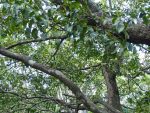 Native to the hot, humid coastal lowland forests of India, Sri Lanka, and Indonesia, this evergreen tree is a member of the family Ebenaceae that also includes persimmon. The tree grows 65-80′ tall and has gray to black bark that is fissured and peeling. The elliptical to obvate, medium green leaves are 2.5-6″ long and have smooth margins and satiny texture. Greenish-yellow, 4-lobed, fragrant male and female flowers appear hidden by the foliage and on different plants in spring. The male flowers are in umbellate clusters of 3-16 while the female flowers are solitary. The round fruit is .8″ across, has a rusty brown velvety skin, and contains 3-8 black seeds. Although edible the fruit is not very tasty. The sapwood is soft, yellowish gray and of no commercial value. The heartwood, however, is black, dense, smooth and has been highly valued since ancient Egyptian times 4500 years ago for furniture as well as decorative items including statuary. The wood is currently used mostly for small items such as crucifixes and parts of musical instruments. The slow growth of the ebony tree makes it a good subject for bonsai. Ebony trees do not tolerate shade, salt spray, drought, or frost so are not suitable for growing outdoors in most of the US but can be grown in a pot and taken indoors during the cold months of the year. The genus name, Diospyros, is from the Greek words dios meaning divine and pyros meaning wheat. The specific epithet, ebenum, is the Latin word meaning ebony black.
Native to the hot, humid coastal lowland forests of India, Sri Lanka, and Indonesia, this evergreen tree is a member of the family Ebenaceae that also includes persimmon. The tree grows 65-80′ tall and has gray to black bark that is fissured and peeling. The elliptical to obvate, medium green leaves are 2.5-6″ long and have smooth margins and satiny texture. Greenish-yellow, 4-lobed, fragrant male and female flowers appear hidden by the foliage and on different plants in spring. The male flowers are in umbellate clusters of 3-16 while the female flowers are solitary. The round fruit is .8″ across, has a rusty brown velvety skin, and contains 3-8 black seeds. Although edible the fruit is not very tasty. The sapwood is soft, yellowish gray and of no commercial value. The heartwood, however, is black, dense, smooth and has been highly valued since ancient Egyptian times 4500 years ago for furniture as well as decorative items including statuary. The wood is currently used mostly for small items such as crucifixes and parts of musical instruments. The slow growth of the ebony tree makes it a good subject for bonsai. Ebony trees do not tolerate shade, salt spray, drought, or frost so are not suitable for growing outdoors in most of the US but can be grown in a pot and taken indoors during the cold months of the year. The genus name, Diospyros, is from the Greek words dios meaning divine and pyros meaning wheat. The specific epithet, ebenum, is the Latin word meaning ebony black.
Type: Evergreen tree
Outstanding Feature: Heartwood
Form: Rounded when young, spreading with age
Growth Rate: Slow
Bloom: Small greenish-yellow male and female flowers on different trees in spring
Size: 65-80′ H
Light:Full sun
Soil: Average, moist, well-drined
Hardiness: Zones 10-11
Care: Low maintenance
Pests and Diseases: None of signficance
Propagation: Fresh seed
Photo Credit: Wikipedia